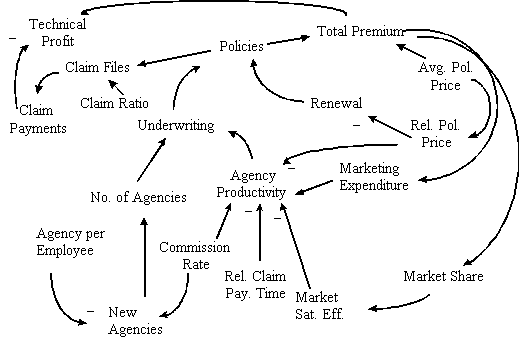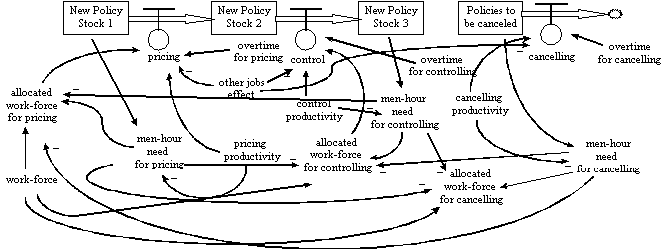
Bebek, ISTANBUL / TURKEY | Zincirlikuyu, ISTANBUL / TURKEY |
I. INTRODUCTION
Managing directors of Halk Sigorta, one of the leading firms in the Turkish insurance sector with its five regional centers and about 500 agencies spread in the country, perceived some potential organizational and non-productivity problems, like stagnation in premium income and market share and increasing number of claim files. Therefore, Halk Sigorta demanded that an external team (BU-System Dynamics Team) review the company in order to analyze and evaluate such problems scientifically and objectively. The main objective of the project was to address the managerial / organizational problems of the company by using dynamic simulation analysis. The dynamics behind the organizational problems of the company were analyzed by building a management simulation model of the company. While the project focused mainly on the "strategic" long-term top management problems, the "tactical" short-term problems at the middle management level were dealt with and modeled as well. Simulation models were handed over to Halk Sigorta in order to enable the managers experiment by themselves. The main profit of the model is that it generates an understanding of within-company and company-market interactions that may be responsible for the potential problems. Thus, the project is the first step of what may be a long term education, research and problem solving process, namely "organizational learning".
II. STRATEGIC MODEL
The strategic model deals with the long-term strategic, macro problems relevant to the top management. The time-unit of the model is one month, and the simulation experiments/runs cover a period of 8-10 years. The sectors of the model are Istanbul Accident, Istanbul Fire, Istanbul Claims, Regions Accident, Regions Fire, Regions Claims, Istanbul Agencies, Regions Agencies, Marketing and Finance. The model generates an understanding of the boom-then-stagnation behavior of the dynamics of Halk Sigorta, at the strategic management level using the interactions between the mentioned sectors. At the end of the study, following observations are made, problems are defined, and solutions are recommended:

III. DEPARTMENT MODELS
Department models focus on the short-term tactical / operational problems, such as work-load / work-force balance in departments, personnel productivity, overtime, staff scheduling etc. Two "typical" departments were modeled: Accident / Automobile and Claims Department. The time unit of these models is one hour, and the simulation experiments cover a period of one month.
III.1. ACCIDENT/AUTOMOBILE MODEL (A/A MODEL)
A/A model is built specifically using the data from the A/A department of Halk Sigorta. But it can be generalized to the other technical departments such as Fire and Transportation which have similar structures and problems. The department is modeled into the following major sectors: New Policy, Personnel, Policy Canceling, Policy Changes, Policy Renewal, Control, Regions Policy, Non-Auto. The model coordinates the work load / work force balance within and between sectors, shifting the work-force according the backlog of jobs in order to prevent large accumulations.

Figure 2 - Modeling the work load/work force balance within the New Policy sub-sector and between New Policy and Cancellations sub-sectors
III.2. CLAIMS MODEL
Claims model focuses the problems of the Claims department which has a unique structure and organization. The model comprises the sectors New Claims, File Processing, Revisions, Payments. The model balances work-load and work-force, controlling job-flows within and between sectors. The overtime applied in claims department is not as high as the in A/A department. Through a flexible and rational work-force scheduling method, the overtime can be eliminated and the productivity can be increased.
IV. CONCLUSION
The production, income, and market share of the company exhibited
a boom in the early nineties and they have stabilized in the recent
years (market share around 7%). The problems identified in the
study, caused partially through external / market factors should
be analyzed as a whole according to the "systems" approach.
As part of a long-term strategic plan, some inter-dependent improvement
projects can be started to address these problems. The main profit
of the model is that it generates an understanding of company's
internal and company-market interactions so as to enable us produce
solutions for the potential problems. The models can be used as
a "learning laboratory" in the company, which would
be a step toward "organizational learning". Of course,
the results valid only under some simplifying assumptions, like
all laboratories. Nevertheless, like all laboratories, it promises
to be beneficial and instructive for the company. The next step
is to build an interactive gaming version of the strategic insurance
management model.
REFERENCES
Doman, A., M. Glucksman, N. Mass, and M. Sasportes, "The Dynamics of Managing a Life Insurance Company", System Dynamics Review, Vol.11, No.3 (Fall 1995), pp.219-232, 1995.
Senge, P.M., "Catalyzing Systems Thinking within Organizations", MIT Working Report, 1987.
Monthly Reports of Halk Sigorta T.A.Þ., Jan'89 to Jun'96, Istanbul, Turkey.
Yearly Reports of Halk Sigorta T.A.Þ., 1989 to 1995, Istanbul, Turkey.
Yearly Reports of Insurance Supervisory Office, 1989 to 1995, Istanbul, Turkey.